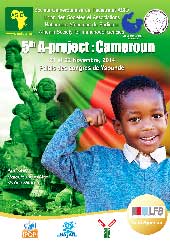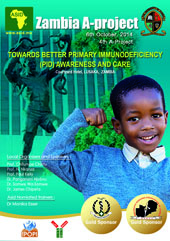Yousif Sulaiman, Idriss Matoug, Abdulla Alteer, Hanan Alsalheen, Salah Alamroni, Fatma Altajori.
Children's Hospital, Faculty of Medicine, Benghazi University, Benghazi, Libya.
Mucocutaneous leishmaniasis is one of different forms of leishmainiasis due to parasitic infection transmitted by sand fly bite. It is caused by L. braziliensis, L. panamensisand, less frequently, L. amazonensis. The infection characterized by lesions of the skin and mucous membranes in the mouth and nose (1,2).
Ataxia telangiectasia ( A-T ) is a rare syndrome, and multiorgan neurodegenerative disorder, the affected children had immunodeficiency and they are more prone to malignancy (3).
A-T is autosomal recessive disease results from loss of ATM protein. Clinically it is characterized by cerebellar ataxia which usually manifests at age of 2 years and oculocutaneous telangiectasia (4).
Mucocutaneous leishmaniasis is very rare disease in Libya, and since it is serious disease, we want to know it's presentation in a patient with primary immuno-deficiency.
Case:
13 years old girl belongs to consanguineous parents, diagnosed with A-T at 6 years old. 3 years ago she had a lesion on tip of the nose and then she had another lesion on her upper lip. No history of travel to endemic area of leishmania.
On physical examination, her weight and height are below the 3rd percentile, pale and evidence of telangiectasia in sclera.
There is ulcerative lesion at tip of nose that extends to anterior part of nasal septum causing disfigurement of her nose. Also there is another big ulcer at the upper lip and angle of the mouth, with new small skin ulcer in right cheek (see figure). She has unsteady gait, hypotonia of all limbs and reduced deep tendon reflexes. No evidence of hepatosplenomegaly.

Biopsy of lesion revealed presence of amastigotes of leishmania parasite and the PCR was positive for leishmania.
Immunoglobulins levels were low for her age ( done at 13 years old )
IgA : 60 mg/dL IgM : 58 mg/dL IgG : 486 mg/dL
WBC : 14.8 X109/ mL HB : 10.6 g/dL platelets : 758 x 109 /mL
Absolute lymphocytic count : 3x 109/ mL
Absolute neutrophilic count : 10.5x 109/ mL
She was treated with multiple courses of intravenous liposomal amphotericin B and sodium stibogluconate. Also plastic surgery was done for her nose. Systemic antibiotics were given for secondary bacterial infection of the lesion. She receives monthly intravenous γ-globulin plus daily oral antibiotic prophylaxis.
Although she received many courses of intravenous liposomal amphotericin B and sodium stibogluconate, she showed poor response to therapy and the lesion extended from nose to involve her lip and cheek. This could be attributed to delay in diagnosis of mucocutaneous leishmaniasis, as this type of leishmania is considered very rare in Libya, and the first biopsy of the lesion was suggestive of tuberculous infection and for that she received initially antituberculous therapy for 3 months before the next biopsy proved the diagnosis of leishmania.
Conclusions:
Although the patient received proper treatment for leishmania, but delay in diagnosis of mucocutaneous leishmaniasis in patients with primary immunodeficiency can lead to poor response to therapy.
Mucocutaneous leishmaniasis should be considered in children with primary immunodeficiency when they have suggestive mucosal lesions even in non endemic regions.
References:
- Palumbo E. Treatment strategies for mucocutaneous leishmaniasis. J Glob Infect Dis.2010;2:147–150.
- Luiz J, Otavio M, Utsch D. Mucocutaneous Leishmaniasis: clinical markers in presumptive diagnosis. Braz. j. otorhinolaryngol. 2011;77(3) : 380-384.
- Crawford TO, Skolasky RL, Fernandez R, Rosquist KJ, Lederman HM. Survival probability in ataxia telangiectasia. Arch Dis Child. 2006;91(7) : 610-1.
- Taylor AM, Byrd PJ. Molecular pathology of ataxia telangiectasia. J Clin Pathol. 2005 ;58(10):1009-15.



























